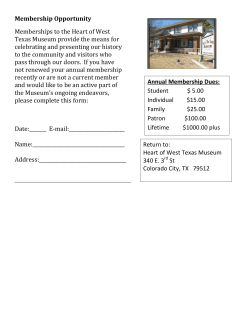
BMA PRESENTS AMERICAN CRAZY QUILTS
Media Contacts: Anne Brown, abrown@artbma.org Sarah Pedroni, spedroni@artbma.org Jessica Novak, jnovak@artbma.org 443-573-1870 BMA PRESENTS AMERICAN CRAZY QUILTS BALTIMORE, MD (May 13, 2015)—The Baltimore Museum of Art will feature seven lavish quilts—a kaleidoscope of silks, velvets, and brocades embroidered with colorful threads—in American Crazy Quilts, on view June 3 through November 29, 2015. Embellished with paint, ribbons, and beads, the crazy quilts on view from the late 1880s have a delightfully arbitrary quality that belies the skillful planning that went into making them. This “crazy” style was the epitome of sophistication at the height of the Victorian era. Making a crazy quilt provided women an opportunity to produce an article for the home that was truly artistic, and according to the era’s philosophy, morally and spiritually uplifting. Though they appear randomly pieced together, crazy quilts’ asymmetrical patterns were unique labors of love and skillfully planned. The time and energy involved in making these quilts was considerable. “It was commenced July 24th, 1883 while staying at Grand Ma's, Mt. Holly,” wrote Marylander Augusta Adele Smith Jones about her quilt on view in the exhibition. “Finished February 13th, 1888 at my home, 1911 Eutaw Place.” “The origin of the crazy quilt, an American invention, is difficult to pinpoint,” said Anita Jones, Curator of Textiles. “One source claimed that the first ‘crazy’ patchwork pattern was created by an inmate in an insane asylum, while others think the technique was a colonial form of quilting.” Modern scholars, however, believe American quilters were inspired by Japanese ceramicists who used crackle glaze that gave objects a cracked appearance. Along with this irregular-looking pattern, Japanese influence can also be seen in motifs such as folding fans, herons, teapots and teacups, vases, butterflies, and dragonflies. Other embroidered subjects include animals, insects, and a wide variety of flowers. American Crazy Quilts will be on view in the Jean and Allan Berman Textile Gallery, located within the renovated American Wing. The gallery highlights works from the BMA’s collection of more than 5,000 textiles spanning nearly 2,000 years. Curated by Anita Jones, Curator of Textiles. —more— American Crazy Quilts/news release Page 2 of 2 THE BALTIMORE MUSEUM OF ART The Baltimore Museum of Art is home to an internationally renowned collection of 19th-century, modern, and contemporary art. Founded in 1914 with a single painting, the BMA today has 95,000 works of art— including the largest holding of works by Henri Matisse in the world. Throughout the museum, visitors will find an outstanding selection of American and European painting, sculpture, and decorative arts; prints and drawings from the 15th century to the present; works by established and emerging contemporary artists; and exceptional objects from Africa and Asia. Two beautifully landscaped gardens display an array of 20th-century sculpture that is an oasis in the city. The 210,000-square-foot museum is distinguished by a grand historic building designed in the 1920s by renowned American architect John Russell Pope. A $28 million multi-year renovation that began in 2010 has transformed galleries for contemporary, American, African, and Asian art, and improved visitor amenities and essential infrastructure. The renovation will conclude with a new center for art, creativity, and community opening in fall 2015 that will offer innovative ways of engaging and interacting with art. Since 2006, the BMA has provided free general admission so that everyone can enjoy the power of art. Visitor Information The Baltimore Museum of Art is open Wednesday through Friday, 10 a.m. – 5 p.m.; Saturday and Sunday, 11 a.m. – 6 p.m. The museum is closed Mondays, Tuesdays, New Year’s Day, July 4, Thanksgiving, and Christmas. The BMA is located at 10 Art Museum Drive at North Charles and 31st Streets, three miles north of Baltimore’s Inner Harbor. For general museum information, call 443-573-1800 or visit artbma.org. Connect with us: #ARTBMA • Blog • Facebook • Twitter • Instagram • YouTube
© Copyright 2025














